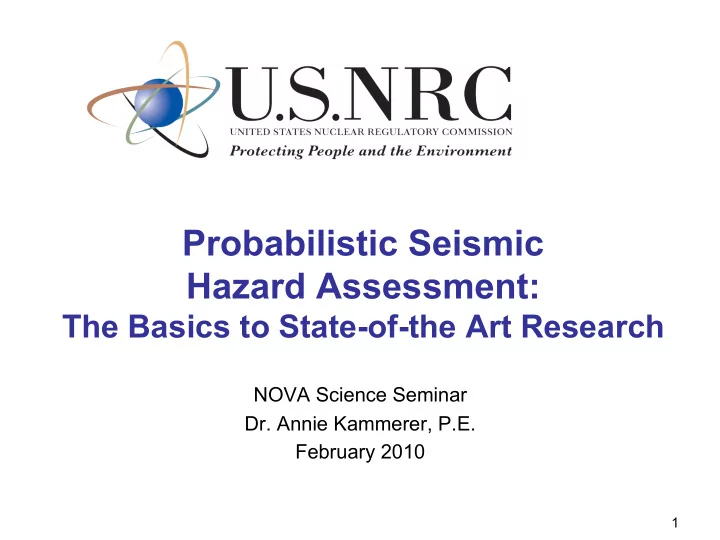

Probabilistic Seismic Hazard Assessment: The Basics to State-of-the Art Research NOVA Science Seminar Dr. Annie Kammerer, P.E. February 2010 1
Overview • Earthquake basics • Earthquake effects • Calculating hazard • Research topics • Structural response (if there’s time) 2
Plate Tectonics 3
US National Hazard Mapping 4
Interplate Regions 5
Intraplate Regions 6
Types of Hazards • Surface rupture • Strong shaking • Fire • Landslides • Liquefaction • Tsunami • Dam/Levee failure 7
Types of Hazards • Surface rupture Primary Effects • Strong shaking • Fire • Landslide Secondary Effects • Liquefaction • Tsunami • Dam/Levee failure 8
Types of Hazards • Surface rupture • Strong shaking • Fire • Landslide • Liquefaction • Tsunami • Dam/Levee failure 9
Surface Rupture Santa Cruz Mountains (1989) 10
Landslide Santa Cruz Mountains (1989) 11
Fire – Broken gas mains – Broken lines to water heaters – Overturned stoves – Lack of water – Big cause of damage (SF, Kobe) 12
Fire Northridge (1994) 13
Liquefaction Liquefaction occurs when saturated loose sands and hydraulic fills experience strong shaking. The soil degenerates into a thick soupy material. 14
Liquefaction • Foundation failures • Breakage of pipes • Floating of underground tanks • Sand boils 15
Liquefaction 16
Liquefaction Niigata earthquake 1964 17
VIDEOS 18
P L 80% 20% 95% 50% 5% 0.6 How do we Non- liquefied Liquefied Marginal Pre-1985 Data “New” Data 0.5 know if there’s a problem? 0.4 Demand CSR* 0.3 0.2 0.1 M W =7.5 σ V '=1.0 atm 0.0 0 10 20 30 40 N 1,60,CS Capacity 19
P L 80% 20% 95% 50% 5% 0.6 Non- liquefied Liquefied Marginal Pre-1985 Data “New” Data 0.5 0.4 How hard the CSR* earthquake will 0.3 shake the site 0.2 0.1 M W =7.5 σ V '=1.0 atm 0.0 0 10 20 30 40 N 1,60,CS Strength of the soil as measured by poking holes in the ground with special equipment 20
Performance-Based Design 21
Strong Shaking How hard will the rock shake? 22
How does the Strong Shaking soil react? How does the rock shake? 23
How do the building and Strong Shaking contents react? How does the rock shake? 24
Strong Shaking • Magnitude • Distance from fault to site • Geology of path and site • Structure 25
How do we know how hard the rock shakes? • Deterministic seismic hazard assessments (DSHA) • Probabilistic seismic hazard assessments (PSHA) 26
Deterministic assessments • Worst case based on known faults • Need fault information and ground motion prediction equations (attenuation relationships) • Problems determining what the worst case is • Different risk levels for different sites 27
Ground Motion Prediction Equations 1.00 Source Type: All Faults Magnitude: 7 Mw Period: 2 seconds Shear Wave Velocity: 760 Magnitude 7 meter/sec Basement Rock Depth: 3 km Alluvium Thickness: 1 m Focal Depth: 6 km Abra.-Silva (1997) Rock USGS 2002 Boore-Joyner-Fumal (1997) USGS 2002 0.10 0.01 0 10 20 30 40 50 60 70 80 90 100 Distance (km) 28
Ground Motion Prediction Equations 1.00 Source Type: All Faults Magnitude: 7 Mw Period: 2 seconds Shear Wave Velocity: 760 Magnitude 7 meter/sec Basement Rock Depth: 3 km Alluvium Thickness: 1 m Focal Depth: 6 km Abra.-Silva (1997) Rock USGS 2002 Boore-Joyner-Fumal (1997) USGS 2002 0.10 0.01 0 10 20 30 40 50 60 70 80 90 100 Distance (km) 29
Probabilistic assessments (PSHA) • The way the NRC does it (RG 1.208) • Considers the probability of different events over time • 10,000 year earthquake (sort of like the 100 year flood) • More complex analysis 30
PSHA For each spectral frequency Find effects of all possible earthquakes, multiply each by the likelihood it will actually happen, combine the events 31
PSHA For each spectral frequency 2 Acceleration (g) Mean Rock UHRS 1 E-6/yr Spectral Acceleration (g) Uniform Hazard Response Spectrum 1 (UHRS) 0 0.1 1 10 100 Frequency (Hz) Natural Frequency 32
Natural frequency 33
2 Mean Rock UHRS 1 E-6/yr Spectral Acceleration (g) 1 0 0.1 1 10 100 Frequency (Hz) 34
PSHA How hard the rock shakes 2 Acceleration (g) Mean Rock UHRS 1 E-6/yr Spectral Acceleration (g) Uniform Hazard Response Spectrum 1 (UHRS) 0 0.1 1 10 100 Frequency (Hz) Natural Frequency 35
Soil Amplification Rock Soil 36
Site Response Divide shaking at top Computer Model by the input motions 10 Amplification Response Spectral Ratio 1 Low-Frequency Site Amplification Function High-Frequency Site Amplification Function 0.1 0.1 1 10 100 Frequency (Hz) Frequency 37
2 10 Mean Rock UHRS 1 E-6/yr Spectral Acceleration (g) Response Spectral Ratio X 1 1 Low-Frequency Site Amplification Function High-Frequency Site Amplification Function 0 0.1 1 10 100 0.1 Frequency (Hz) 0.1 1 10 100 Frequency (Hz) 3 Soil-based 1 E-5 Mean Soil UHRS Mean Rock UHRS Scaled By Low-Frequency Amplification Function Mean Rock UHRS Scaled By High-Frequency Amplification Function uniform Spectral Acceleration (g) 2 hazard response 1 spectrum 0 0.1 1 10 100 38 Frequency (Hz)
Ground Motion Response Spectrum (GMRS) Multiply UHRS by design factors to account for risk to get GMRS GMRS is used to determine the safe shutdown earthquake (SSE) ground motion 39
US NRC Projects to Assess Seismic Hazard in CEUS Central and Eastern US Seismic Source Source Characterization project for Characterization Nuclear Facilities (CEUS SSC) Ground motion Next Generation Attenuation prediction equations Relationships for the Central and Eastern (NGA-East) Recommendations for Implementation Framework for large of SSHAC Guidelines for Level 3 PSHA studies and 4 Processes 40
Structural dynamics 41
Structural dynamics 42
Structural dynamics 43
Group Participation 44
Soil Structure Interaction (SSI) Picture from Gazetas et al. 45
Questions? 46
Recommend
More recommend